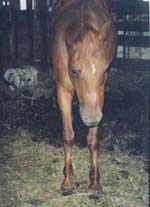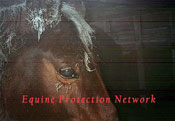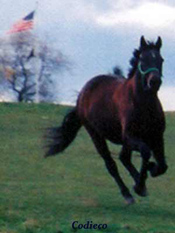
Legislation Information
Pending Legislation
PA's Electronic Bill Room
Type in the word "equine" in the search box to locate bills, (proposed legislation) relating to horses.
Federal Laws
Proposed regs will legalize every inhumane practice identified in the transport of horses to slaughter!
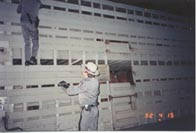
Doubles will be legal for 5 years AFTER the proposed regs go into effect. It has already been 4 1/2 years, that makes for 10 years of the continued use of doubles after this legislation passed..
EPN's Comments
on Proposed Regulations For the 1996 Commercial Transportation of Horses To Slaughter Act
CA Equine Council's
Comments on the Proposed Regulations For the 1996 Commercial Transportation of Horses To Slaughter Act
State Laws
Proposition 6,
The PROHIBITION of Horse Slaughter and Sale of Horsemeat for Human Consumption Act Of 1998, Does Not Violate The Commerce Clause
Horsemeat Laws
1996 Commercial Transportation Of Horses To Slaughter Act
December 7, 2001
Final Rule Commercial Transportation of Horses to Slaughter Act
American Horse Council, American Horse Protection Association, & Humane Society of US
propose to legalize every inhumane practice identified in the transport of horses to slaughter & put the very people identified as the abusers, the "killer buyers" in charge of the horses!
Proposed Regulations For the 1996 Commercial Transportation of Horses To Slaughter Act
USDA Animal & Plant Health Inspection Service, APHIS
Approval of Livestock Facilities;
Interstate Movement of EIA Reactors
USDA Food Safety Inspection Service, FSIS, Regulations
Biological Residues in Horses;
Slaughter of Foaling Mares;
Slaughter of Sick Horses;
USDA APHIS Humane Slaughter Act

AZ Transport Law
CA Transport Law
CT Transport Law
MA Transport Law
MN Transport Law
NY Transport Law
Ag and Markets, Section 359-a
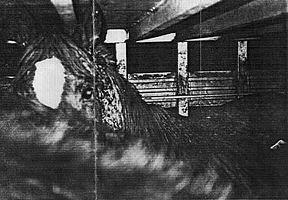
Horses inside double deck cattle trailer stopped by the NYSP. The owner was later convicted & fined $3000.00.
VA Transport Law
Vermont Transport Law
PA Anti Cruelty Law
Title 18, Section 5511
Sign Posted at PA Horse Auctions is NOT the Law!
Sign outside auctions is incorrect!
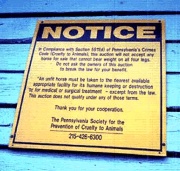
Sign posted outside 2 PA horse auctions regarding the PA Anti Cruelty Statute is incorrect! " Maybe the posting of this sign has something to do with "the agreement" that the auctions and the PA SPCA have with each other...
U.S. Anti-Cruelty Statutes
PA Domestic Animal Act
Licensing of Dealers & Haulers
EIA Regulations, Coggins Test
PA Dead Animal Act
Requirements for Removal of Dead Animals
PA Animal Markets
General Provisions
Records
Transactions From Trucks
IL Horsemeat Act
Texas Law
Sale of Horsemeat for Human Consumption
Prohibits Sale of Horsemeat For Human Consumption
Texas Attorney General Cornyn States TX Law
Prohibiting Sale of Horsemeat Applies to the 2 Texas Horse Slaughterhouses!
Links
California Voters "Just Say Neigh" to Horse Slaughter!
HoofPAC
Shop online at IGive.com with over 400 great stores you know & love- including Back In the Saddle! Up to 26% of the purchase price is donated to the EPN!
The EPN gets $5 extra the first time you shop!
PayPal accepts credit cards! Please send your tax deductible donation to the:Equine Protection Network, Inc.,
P. O. Box 232, Friedensburg, PA, 17933.
Shop for CD's at CDRush.com & the EPN Benefits!
Put "EPN" in the Coupon Code box when you place your order.
Now you can save money on your favorite music and help the horses at the same time!
HoofPAC is the political action committee that has been formed to end the slaughter of America's horses. Cathleen Doyle, founder of HoofPAC, led the successful Save The Horses campaign in 1998 that made the slaughter of California's horses a felony.

Proposed Regulations for the Commercial Transportation of Horses To Slaughter
EPN's Position
The proposed regulations for the Commercial Transportation of Horses To Slaughter Act have been published in the Federal Register.The Federal Register is online.
Check the box "1999" AND the box "Proposed Rules"
In the Search Term Box type, "horse"
Scroll down to Commercial Transportation of Equines to Slaughter
Read the TEXT.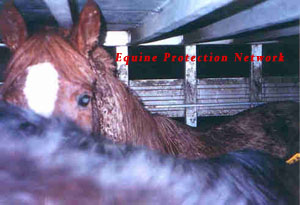
Read the CA Equine Council's Comments on the Proposed Regulations!
Premarin Foals Will Be Exempt !
The American Horse Council & The American Horse Protection Association supported these proposed regulations in their recommendations to the USDA.
The proposed regulations are for the Commercial Transportation of Horses to Slaughter Act which passed in 1996. The Act stated that the,
"Secretary of Ag may issue guidelines to regulate the transportation of horses to slaughter..."
Many people mistakenly believed that when the law passed the horses were protected. Not so. The law simply stated that the Secretary of Ag had the authority to create guidelines. The proposed regulations are these guidelines.
The words "safe" and "humane" do NOT exist in the law.
The original intent of this law was to ban the use of double deck cattle trailers, ban the shipment of pregnant mares and foals to slaughter, ban the shipment of sick & injured horses by having a veterinarian inspect the horses, require ceiling height of no less than 6'6", require secure footing & safe interiors, water, food & rest no less than every 12 hours, limit the number of horses on a trailer, segregate horses by size & sex.
The Proposed Regulations will Allow the Following;
- Double deck cattle trailers will continue to be legal for another 5 years. These trailers can have ceiling heights as low as 5'7". Commercial horse trailers are no lower than 6'6", with most being 7' to 8' tall. Using a conservative number of 200 horses in a double deck a week, that is 10,400 horses a year, or 52,000 horses over the next 5 years that will continue to be forced to ride in trailers designed for cattle and hogs that do not allow the horses to stand upright and cause head, back & neck injuries.
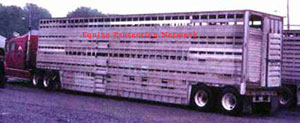
- It will be legal to ship horses 28 hours with no water, no food, & no rest. Equine industry transport standards are water every 4-6 hours depending on the weather. Equine husbandry practices recommend water no_less_ than every 12 hours. Horses are transported in boarded up trailers during the summer when outside temperatures are exceeding 90 degrees. With 40 - 45 horses in a trailer it is impossible for these horses to receive enough ventilation. Horse industry standard for the same size trailer is 8 to 15 horses.
 Full
term pregnant mares can be shipped to slaughter, as long as the owner / shipper, the very person who stands to benefit by shipping the mare & the person who stands to lose money if the mare is not shipped, does not believe the mare will foal during the trip. Equine veterinarians have stated that they cannot predict when a mare is going to foal.
Full
term pregnant mares can be shipped to slaughter, as long as the owner / shipper, the very person who stands to benefit by shipping the mare & the person who stands to lose money if the mare is not shipped, does not believe the mare will foal during the trip. Equine veterinarians have stated that they cannot predict when a mare is going to foal.
- The owner / shipper, the very person identified as the person(s) inflicting the inhumane treatment to slaughter horses have been put in charge of determining whether or not a horse is fit to ship instead of a veterinarian. Considering that the owner/shipper stands to lose money if the horse does not ship, & stands to profit if the horse does ship, this is an apparent conflict of interest.
- Penalties will be civil, not criminal. In other words law enforcement cannot enforce. Enforcement will be at the slaughterhouse, not at auctions or feedlots prior to loading. The USDA is in charge of enforcing the regulations. The USDA is currently not enforcing their regulations at horse auctions. How will the USDA enforce these guidelines?
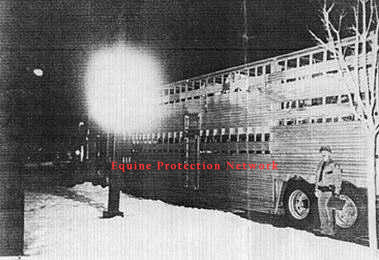
- Language is performance based instead of engineering based. Performance based language makes enforcement more difficult.
The proposed regulations fly in the face of every accepted horse transportation industry practice, horse management practice & horse husbandry practice. Horses bound for slaughter are still horses, they have not shrunk in size, their behavior has not changed, their need for water has not changed. They are still alive & need to be transported in vehicles designed to transport horses & using methods designed for horses.
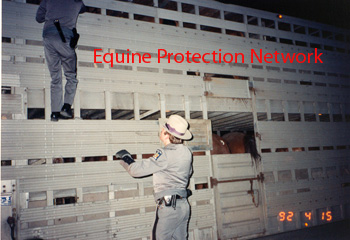 New York State banned double deck trailers and instituted safety standards for horse trailers 18 years ago & has stepped up enforcement of their transport law, Sec 359-a. New York State continues to use its law to crack down on the cruel and inhumane transport of slaughterbound horses from Pennsylvania auctions through New York to Canadian slaughterhouses for human consumption overseas. The simplicity of New York State's law facilitates the prosecution and conviction for illegal shipment of horses, and New York State counties have seen revenue of $7700 in a 12 month period, with over $11,000 in unpaid fines on the books.
New York State banned double deck trailers and instituted safety standards for horse trailers 18 years ago & has stepped up enforcement of their transport law, Sec 359-a. New York State continues to use its law to crack down on the cruel and inhumane transport of slaughterbound horses from Pennsylvania auctions through New York to Canadian slaughterhouses for human consumption overseas. The simplicity of New York State's law facilitates the prosecution and conviction for illegal shipment of horses, and New York State counties have seen revenue of $7700 in a 12 month period, with over $11,000 in unpaid fines on the books.
As of October 2004 there have been numerous violations, often by the same dealer/hauler. Of the 12 cases that are closed, NO FINES were levied, only official warnings.
31 cases remain open, some from as early as 2003.
The most common is horses being transported more than 28 hours with no food, water, or rest. There continues to be violations at livestock markets throughout the United States.
The EPN and the CEC opposed these regulations from the beginning. Our predictions about a lack of enforcement have come true. The EPN accomplished more by simply providing the information to the NYSP so they could enforce the law that had been on the books for 20 years.
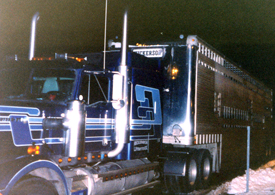 |
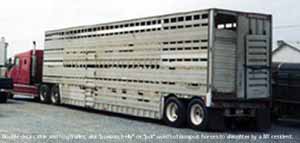 |
| Doubles Used in Violation of NY Law | |
|
Horse Popsicle Case |
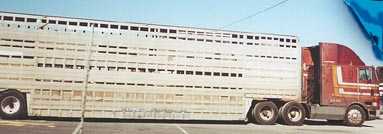 |
Save America's Horses! |
|||||||
|
Please send your tax deductible donation to: Equine Protection Network, Inc., P. O. Box 232, Friedensburg, PA, 17933 |
||
Save America's Horses- Make the Commitment to Your Horse! |
||
|
Photos On This Page CANNOT be Used Without Written Permission |
||
